Introduction
Overall Design
{{section_header}}{{section.name}}{{/section_header}}
The {{product.name}} has a fairly basic design, but no design elements that make it look ugly.
Front
{{section_header}}{{section.name}}{{/section_header}}

Back
{{section_header}}{{section.name}}{{/section_header}}

Sides
{{section_header}}{{section.name}}{{/section_header}}

Stand/Mount
{{section_header}}{{section.name}}{{/section_header}}
The stand of the {{product.name}} has a high-gloss and no swivel. Even though it is a little annoying to have to physically move the entire set to reach the back, at least it's not nigh-impossible to do.

Controls
{{section_header}}{{section.name}}{{/section_header}}
The physical controls of the {{product.name}} are located on the right side of the TV set, with unlit buttons that are somewhat difficult to tell which function they perform in the dark.
Remote Control
{{section_header}}{{section.name}}{{/section_header}}
The included remote control of the {{product.name}} is very light in the hand, and fairly balanced with a light grip. The buttons so have a slightly long key travel though, but nothing that would significantly slow operation of the TV set.

In the Box
{{section_header}}{{section.name}}{{/section_header}}
The {{product.name}} comes packaged with batteries, remote, assorted documentation, cable management system and power cable.
Black Level
{{section_header}}{{section.name}}{{/section_header}}
The {{product.name}} recorded a black level of 0.09 cd/m2 in our lab, which isn't earth-shattering, but is pretty good all things considered. We typically look for a level that is under 0.1 cd/m2 at least, so the {{product.name}} squeaks in here. More on how we test black level.
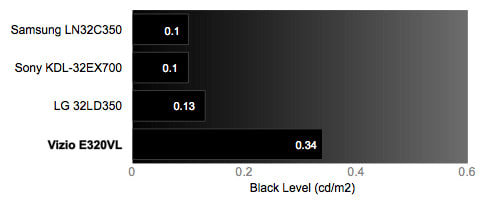
Peak Brightness
{{section_header}}{{section.name}}{{/section_header}}
The {{product.name}} has a peak brightness of 359.19 cd/m2, while not the 400+ cd/m2 claimed by Philips, is still impressive. When watching TV in a brightly-lit room, you need around 200 cd/m2 of brightness, so the level of the {{product.model}} should be more than you'll ever really need in this regard. More on how we test peak brightness.
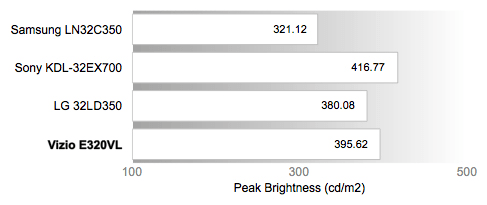
Contrast
{{section_header}}{{section.name}}{{/section_header}}
Due to the decently low black level and the respectable peak brightness, the {{product.name}} has a pleasantly wide contrast ratio of 3991:1, which gives it a distinct advantage over a good chunk of its competitors. More on how we test contrast.

Tunnel Contrast
{{section_header}}{{section.name}}{{/section_header}}
As you can see from the chart below, the {{product.name}} had only minor issues displaying a consistently low black level depending upon how much area white took up on the screen. More on how we test tunnel contrast.
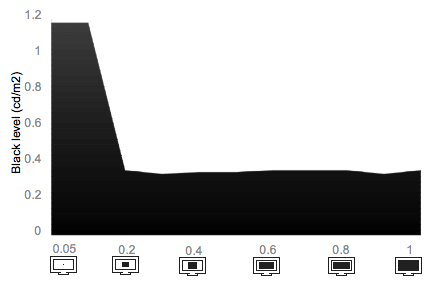
White Falloff
{{section_header}}{{section.name}}{{/section_header}}
The {{product.name}}'s performance in white falloff was a little disappointing, given that whites tend to darken if they are surrounded by a large area of black on the screen. More on how we test white falloff.
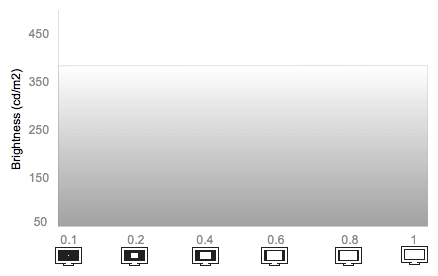
Uniformity
Greyscale Gamma
{{section_header}}{{section.name}}{{/section_header}}
When we test greyscale gamma, we look at two aspects of our charts before scoring a TV’s performance: the smoothness and slope of the line. The smoothness of the line tells us whether or not there were certain values of signal intensity that the TV simply couldn’t produce, or if they were produced incorrectly. Ideally, the slope of the line should lie somewhere between 2.1 and 2.2, but depending on a TV’s performance, this may vary. If it does vary, that means it doesn’t quite produce the ideal values along the greyscale, which can result in lost detail, especially in shadows.
The {{product.model}}'s gamma response was surprisingly bad. In addition to several issues in the darkest end with a jagged line (meaning detail will often be lost in shadows), the slope of the line was 3.01, which is far outside our ideal range for slope. If you own this TV set, you may notice loss of detail in shaded areas often. More on how we test greyscale gamma.
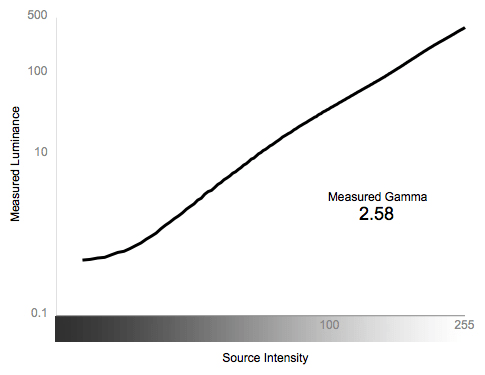
Color Temperature
{{section_header}}{{section.name}}{{/section_header}}
The {{product.name}}'s color temperature error was so bad our scoring algorithms would not award it even a single point. Looking at our provided chart, you'll see that it has a significantly bad warming problem as the screen's signal intensity darkens. You will absolutely notice this problem in darker scenes. More on how we test color temperature.

RGB Curves
{{section_header}}{{section.name}}{{/section_header}}
The {{product.name}}'s RGB curves were mediocre overall. You'll notice that at the beginning of the curves, the red response pattern shows a dip in the line, then a correction. This means that there were a few values of red that the TV simply could not reproduce accurately. Similarly, the lines for each response were a bit jagged and uneven, which means that this problem persisted throughout the entire test, though not as badly as it was with the big dip at the beginning. Be wary of color banding in your picture, especially in shadows or gradients. More on how we test RGB curves.

Below are linear representations of each RGB curve as compared to the ideal response and that of the three other comparison models.
Motion Performance
{{section_header}}{{section.name}}{{/section_header}}
Overall, the motion performance of the {{product.name}} was thoroughly uninspiring, as pictures in motion lose a lot of detail. There was also no additional video processing to help handle film content, but luckily it handles 24p media decently, without much to note in the way of problems. More on how we test motion performance.
3:2 Pulldown & 24fps
{{section_header}}{{section.name}}{{/section_header}}
The {{product.name}} handles film content well without any additional video processing, without any strobing or jitter in high-frequency patterns. More on how we test 3:2 pulldown and 24fps.
Resolution Scaling
{{section_header}}{{section.name}}{{/section_header}}
The {{product.name}} has a native resolution of 1080p, but not all content out there will be broadcast in a 1080p signal, so your TV set will be forced to rescale the signal based on its original format. Below is how the {{product.name}} handled each NTSC resolution. More on how we test resolution scaling.
480p
The {{product.name}} lost 2% of its image vertically, and 3% of its image horizontally to overscan, but did not suffer from any other setbacks while displaying 420p content.
720p
The {{product.name}} suffered the same amount of overscan as the 420p content, but also started to show signs of issues with high-frequency patterns and legibility in this resolution.
Formats
{{section_header}}{{section.name}}{{/section_header}}
The {{product.name}} has a native resolution of 1080p and can display all standard NTSC resolutions.
Viewing Angle
{{section_header}}{{section.name}}{{/section_header}}
The viewing angle of the {{product.name}} is disappointingly tiny, as the set only maintains more than 50% of its contrast ratio when it is viewed within 15 degrees from center. As you can see in the chart, this is small, even for other TV sets of its relative size.

Reflectance
{{section_header}}{{section.name}}{{/section_header}}
LCD screens are not typically as bad as plasma screens in reflectiveness, and the {{product.name}} is no different. In fact, it does a decent job of minimizing reflection angle and annoyance when a bright light is shone directly into the screen.
Video Processing
{{section_header}}{{section.name}}{{/section_header}}
This is the part of the review where you'd normally see a summary of the efficacy of the video processing features of the {{product.model}}. Instead, you will only read that the {{product.model}} has none, really. Nothing more needs to be said here.
Calibration
{{section_header}}{{section.name}}{{/section_header}}
The {{product.name}} is very straightforward to calibrate, with only a few options for the user to mess around with, and no additional video processing. The downside to this is that there is no way for the user to manually adjust the backlight setting, as it is stuck permanently on one level. Using movie mode as a starting point, we calibrated the {{product.model}} as follows:

All of our calibration is done in conjunction with the DisplayMate software.
](http://www.displaymate.com/)
Video Modes
{{section_header}}{{section.name}}{{/section_header}}
The {{product.name}} has a handful of video mode presets, each altering the settings to your TV to suit certain viewing environments.
Connectivity
{{section_header}}{{section.name}}{{/section_header}}
The back of the {{product.name}} is home to the interesting array of connectivity options, many of which are becoming more and more rare on newer televisions in 2011, like the dual S-video ports. In addition to the aforementioned S-video ports, there is 1 composite video port, 1 component video input, 2 HDMI ports and a cable/ANT input port. Also available are analog and digital audio output options, if you would like to spare yourself the experience of the twin 3-watt speakers.

On the side of the set lives the lone USB port, a third HDMI port, another composite video input, and an s-video port.
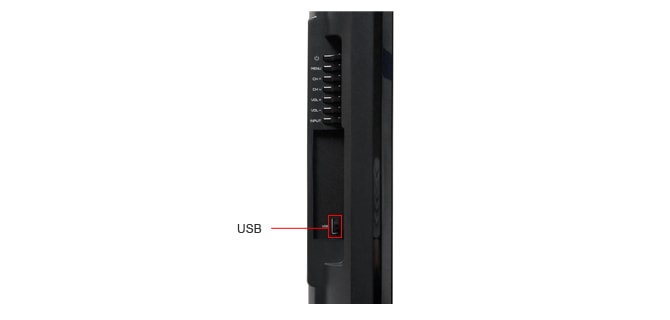
Placement
{{section_header}}{{section.name}}{{/section_header}}
The placement of the ports on the {{product.name}} is logical, even if it means that a wall mount may not be the smartest thing for you to use with the rear port panel. Still, the sideways-facing port panel allows you the use of most of the connections you could ever want, so this isn't an impossibility.
Audio Quality
{{section_header}}{{section.name}}{{/section_header}}
The audio quality of the twin 3-watt speakers is underwhelming at best, and offensive at worst, so you may want to consider hooking up an external sound system if you want to make the most of your programs or movies with this TV set. The audio menu has a pared-down equalizer, which is a little mystifying as the speakers are incapable of producing good sound.
Menu Interface
{{section_header}}{{section.name}}{{/section_header}}
The menu interface of the {{product.name}} is extremely simplistic, even if it isn't terribly unattractive. Navigation is simple and straightforward, despite the eco settings being enabled in a rather odd spot in the menu. Surprisingly absent from the {{product.name}}'s menu is a backlight control.

In addition to the basic picture control menu is an audio control menu with a pared-down equalizer. Again, we're not sure why this thing has an equalizer, but it's there if you want to adjust it.

Instruction Manual
{{section_header}}{{section.name}}{{/section_header}}
The instruction manual of the {{product.name}} is informative and logically ordered, but the total amount of information is a little sparse. Still, this TV doesn't have any internet connectivity or bluetooth, so really there aren't a lot of advanced options available to you anyways.

A manual for so many TV models, they have to be further categorized by type.
Internet Features
{{section_header}}{{section.name}}{{/section_header}}
The {{product.name}} has no internet features. If you really need these on your TV, be prepared to hook up a streaming device via HDMI.
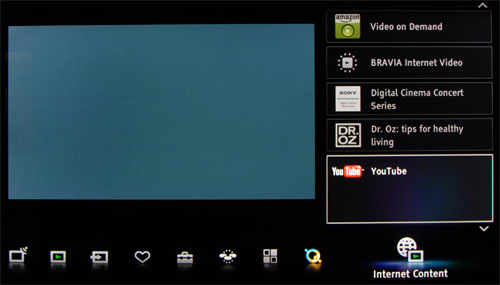
Local Media Playback
{{section_header}}{{section.name}}{{/section_header}}
Via the USB port on the back of the unit, you can plug in a thumb drive or other USB device to play back JPEG photo files, or MP3 audio files. Sadly, there are no other file formats supported. Still, if you're listening to music, we'd recommend using an external sound system instead of the {{product.model}}'s speakers, as they are quite underwhelming.
WIth .jpeg files, the {{product.model}} allows you to create a slideshow, and control transitions using a series of somewhat cheesy wipes. Keep in mind that any photo above 1920x1080 will not be supported, and therefore is not viewable on the {{product.name}}.

From looking at the menus and the music playback screen, it's painfully obvious that local media playback was more of an afterthought for the {{product.model}}. Still, considering that the {{product.manufacturer_specs['Series Name']}} series seems to be little more than computer monitors paraded around as TVs, it's not terribly surprising that not all of the features that make these units more like a modern TV will be a bit rushed or underdeveloped.
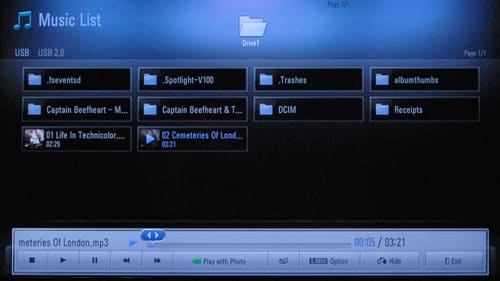
Other Media
{{section_header}}{{section.name}}{{/section_header}}
The {{product.model}} does not support any other type of media.
Power Consumption
{{section_header}}{{section.name}}{{/section_header}}
The inability to adjust the backlight made our job in the lab easier, but it does mean that your TV will constantly be at maximum brightness. Thankfully, the {{product.name}} isn't exactly a power hog, as it draws around 87 watts during normal use. If you stretch that out over a year of normal viewing, you're probably only going to see an impact of $17.12 on your power bill. It's not as much as a plasma would do, but we typically see LCD televisions draw less power.
Below you can see how the {{product.name}} stacks up against the competition. You'll see that while it's a little more efficient than the Vizio, it definitely falls behind against the Sony and the Toshiba.
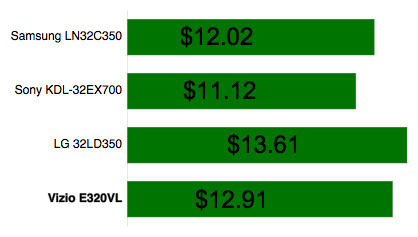
Value Comparison
{{section_header}}{{section.name}}{{/section_header}}
Despite the fact that the Vizio is slightly cheaper, you will get a better TV set in many areas like motion performance, color performance and a slightly better viewing angle if you pick it over the {{product.name}}. In addition, the larger screen may make this a better buy for many consumers.
Blacks & Whites
{{section_header}}{{section.name}}{{/section_header}}
The {{product.name}} absolutely trounces the underperforming Vizio in this area, not only by recording a lower black level, but also by out-shining its peak brightness. Still, the Vizio has better greyscale gamma, so this isn't a total landslide victory for the Philips

Color Accuracy
{{section_header}}{{section.name}}{{/section_header}}
The Vizio has much better color accuracy almost across the board here, but it does slip a little bit behind in RGB curves, though the performance is fairly close.
Motion
{{section_header}}{{section.name}}{{/section_header}}
The Vizio's motion performance is not as bad as the {{product.name}}'s, but don't take that to mean that it's good, either. Neither TV did well here.
Viewing Effects
{{section_header}}{{section.name}}{{/section_header}}
Both sets have a disappointingly narrow viewing angle.
Connectivity
{{section_header}}{{section.name}}{{/section_header}}
While the {{product.name}} has more analog audio and s-video ports, the Vizio has, well, nothing that would really give it an edge here. If connections are important to you, stick with the {{product.name}} here.
Value Comparison
{{section_header}}{{section.name}}{{/section_header}}
This one's a bit unfair, as the Sony is much more expensive than the {{product.name}}, but for that extra money you spend, you'll be getting improved black and white performance, streaming internet content and more connectivity options.
Blacks & Whites
{{section_header}}{{section.name}}{{/section_header}}
Both the {{product.name}} and the Sony did well here, but if you're looking for the best, the Sony did technically do better than the {{product.model}} by having a lower deepest black, and higher contrast ratio.

Color Accuracy
{{section_header}}{{section.name}}{{/section_header}}
This one is a hands-down victory for the Sony, as it blew the {{product.name}} away in every category.
Motion
{{section_header}}{{section.name}}{{/section_header}}
Surprisingly enough, the {{product.name}} handles motion better than the higher-end Sony, but neither TV handles motion in a way that we would consider "good."
Viewing Effects
{{section_header}}{{section.name}}{{/section_header}}
Neither TV set has a good viewing angle, but the Sony has a slightly larger one than the {{product.name}}.
Connectivity
{{section_header}}{{section.name}}{{/section_header}}
If plentiful modern connection options are important to you, you're going to want the Sony. If for some reason you need the ancient s-video connections, you're going to want the {{product.name}}
Value Comparison
{{section_header}}{{section.name}}{{/section_header}}
Another higher-priced comparison, the {{product.name}} battles the Toshiba well on some fronts, trouncing it in black and white performance, but falling behind in local media, color performance and motion scores.
Blacks & Whites
{{section_header}}{{section.name}}{{/section_header}}
The {{product.name}} not only has a better deepest black level, but also a higher peak brightness, and consequently, a much wider contrast ratio. Stick with the {{product.name}} if contrast is your biggest concern.

Color Accuracy
{{section_header}}{{section.name}}{{/section_header}}
Not surprisingly, the Toshiba has a much better color score (given that the {{product.model}} scored a 0.00 on color temperature error), and overall leaves the {{product.name}} in the dust here.
Motion
{{section_header}}{{section.name}}{{/section_header}}
We hesitate to say that either TV handles motion well, but the Toshiba technically does a better job at handling motion.
Viewing Effects
{{section_header}}{{section.name}}{{/section_header}}
Even though it's still relatively tiny, the Toshiba's viewing angle is about twice that of the {{product.name}}.
Connectivity
{{section_header}}{{section.name}}{{/section_header}}
The Toshiba has a lot more modern connectivity options than the {{product.name}}, which relies on the ancient relic s-video ports to boost its score.
Conclusion
Overall, you're getting a little less than what you pay for with the {{product.name}}, as there are some glaring low points to this TV that might make consumers look elsewhere for a TV set. If you're looking to have a unit that hangs out in the kitchen while you cook or for a bedroom, this TV isn't a bad pickup; however you're kidding yourself if you buy this hoping to build a decent home entertainment center around it.
The color performance of this TV was so wretchedly bad that it lags far behind most of the other 2011 TVs, and if you care about picture quality, the performance fielded by the {{product.name}} is unacceptable. Despite its wide contrast ratio, it's prone to detail loss and color banding, and overall it does not perform on par with other models it is meant to compete with. In fact, there's good reason to believe that this television is nothing more than a computer monitor that was pushed into service as a TV at the last minute.
Model Series Comparison
{{section_header}}{{section.name}}{{/section_header}}
The Philips xxPFL4505D series contains the 32PFL4505D, the 22PFL4505D, and the 19PFL4505D. All three television sets are 1080p, LED-backlit screens with no internet capabilities, but similar connectivity options.
Photo Gallery
{{photo_gallery "Front Tour Image", "Back Tour Image", "Sides Tour Image", "Stand Photo", "Controls Photo", "Remote Control Photo", "Connectivity Tour Image 1", "Connectivity Tour Image 2", "Connectivity Extra Photo", "Menu Main Photo", "Menu 2 Photo", "Internet Features 1 Photo", "Internet Features 2 Photo", "Internet Features 3 Photo", "Local Media Playback 1 Photo", "Local Media Playback 2 Photo"}}
Ratings & Specs
{{manufacturer_specs_table}}
Meet the tester
A seasoned writer and professional photographer, Chris reviews cameras, headphones, smartphones, laptops, and lenses. Educated in Political Science and Linguistics, Chris can often be found building a robot army, snowboarding, or getting ink.
Checking our work.
Our team is here for one purpose: to help you buy the best stuff and love what you own. Our writers, editors, and lab technicians obsess over the products we cover to make sure you're confident and satisfied. Have a different opinion about something we recommend? Email us and we'll compare notes.
Shoot us an email
